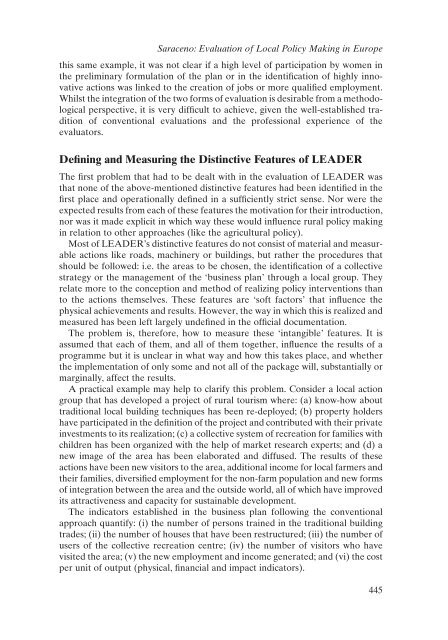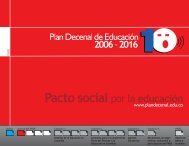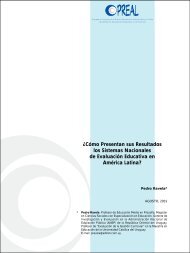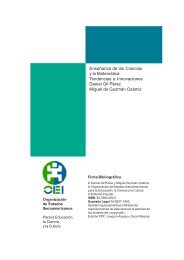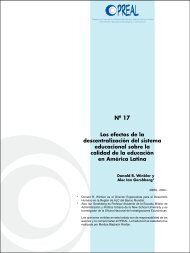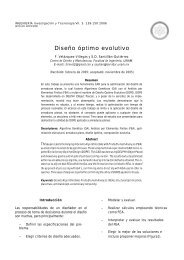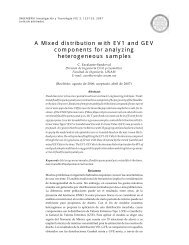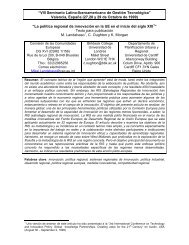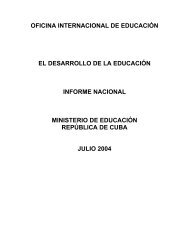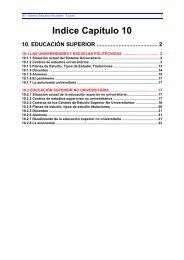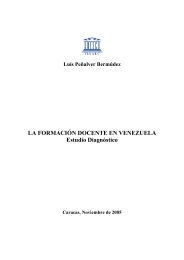The Evaluation of Local Policy Making in Europe - OEI
The Evaluation of Local Policy Making in Europe - OEI
The Evaluation of Local Policy Making in Europe - OEI
Create successful ePaper yourself
Turn your PDF publications into a flip-book with our unique Google optimized e-Paper software.
Saraceno: <strong>Evaluation</strong> <strong>of</strong> <strong>Local</strong> <strong>Policy</strong> <strong>Mak<strong>in</strong>g</strong> <strong>in</strong> <strong>Europe</strong><br />
this same example, it was not clear if a high level <strong>of</strong> participation by women <strong>in</strong><br />
the prelim<strong>in</strong>ary formulation <strong>of</strong> the plan or <strong>in</strong> the identification <strong>of</strong> highly <strong>in</strong>novative<br />
actions was l<strong>in</strong>ked to the creation <strong>of</strong> jobs or more qualified employment.<br />
Whilst the <strong>in</strong>tegration <strong>of</strong> the two forms <strong>of</strong> evaluation is desirable from a methodological<br />
perspective, it is very difficult to achieve, given the well-established tradition<br />
<strong>of</strong> conventional evaluations and the pr<strong>of</strong>essional experience <strong>of</strong> the<br />
evaluators.<br />
Def<strong>in</strong><strong>in</strong>g and Measur<strong>in</strong>g the Dist<strong>in</strong>ctive Features <strong>of</strong> LEADER<br />
<strong>The</strong> first problem that had to be dealt with <strong>in</strong> the evaluation <strong>of</strong> LEADER was<br />
that none <strong>of</strong> the above-mentioned dist<strong>in</strong>ctive features had been identified <strong>in</strong> the<br />
first place and operationally def<strong>in</strong>ed <strong>in</strong> a sufficiently strict sense. Nor were the<br />
expected results from each <strong>of</strong> these features the motivation for their <strong>in</strong>troduction,<br />
nor was it made explicit <strong>in</strong> which way these would <strong>in</strong>fluence rural policy mak<strong>in</strong>g<br />
<strong>in</strong> relation to other approaches (like the agricultural policy).<br />
Most <strong>of</strong> LEADER’s dist<strong>in</strong>ctive features do not consist <strong>of</strong> material and measurable<br />
actions like roads, mach<strong>in</strong>ery or build<strong>in</strong>gs, but rather the procedures that<br />
should be followed: i.e. the areas to be chosen, the identification <strong>of</strong> a collective<br />
strategy or the management <strong>of</strong> the ‘bus<strong>in</strong>ess plan’ through a local group. <strong>The</strong>y<br />
relate more to the conception and method <strong>of</strong> realiz<strong>in</strong>g policy <strong>in</strong>terventions than<br />
to the actions themselves. <strong>The</strong>se features are ‘s<strong>of</strong>t factors’ that <strong>in</strong>fluence the<br />
physical achievements and results. However, the way <strong>in</strong> which this is realized and<br />
measured has been left largely undef<strong>in</strong>ed <strong>in</strong> the <strong>of</strong>ficial documentation.<br />
<strong>The</strong> problem is, therefore, how to measure these ‘<strong>in</strong>tangible’ features. It is<br />
assumed that each <strong>of</strong> them, and all <strong>of</strong> them together, <strong>in</strong>fluence the results <strong>of</strong> a<br />
programme but it is unclear <strong>in</strong> what way and how this takes place, and whether<br />
the implementation <strong>of</strong> only some and not all <strong>of</strong> the package will, substantially or<br />
marg<strong>in</strong>ally, affect the results.<br />
A practical example may help to clarify this problem. Consider a local action<br />
group that has developed a project <strong>of</strong> rural tourism where: (a) know-how about<br />
traditional local build<strong>in</strong>g techniques has been re-deployed; (b) property holders<br />
have participated <strong>in</strong> the def<strong>in</strong>ition <strong>of</strong> the project and contributed with their private<br />
<strong>in</strong>vestments to its realization; (c) a collective system <strong>of</strong> recreation for families with<br />
children has been organized with the help <strong>of</strong> market research experts; and (d) a<br />
new image <strong>of</strong> the area has been elaborated and diffused. <strong>The</strong> results <strong>of</strong> these<br />
actions have been new visitors to the area, additional <strong>in</strong>come for local farmers and<br />
their families, diversified employment for the non-farm population and new forms<br />
<strong>of</strong> <strong>in</strong>tegration between the area and the outside world, all <strong>of</strong> which have improved<br />
its attractiveness and capacity for susta<strong>in</strong>able development.<br />
<strong>The</strong> <strong>in</strong>dicators established <strong>in</strong> the bus<strong>in</strong>ess plan follow<strong>in</strong>g the conventional<br />
approach quantify: (i) the number <strong>of</strong> persons tra<strong>in</strong>ed <strong>in</strong> the traditional build<strong>in</strong>g<br />
trades; (ii) the number <strong>of</strong> houses that have been restructured; (iii) the number <strong>of</strong><br />
users <strong>of</strong> the collective recreation centre; (iv) the number <strong>of</strong> visitors who have<br />
visited the area; (v) the new employment and <strong>in</strong>come generated; and (vi) the cost<br />
per unit <strong>of</strong> output (physical, f<strong>in</strong>ancial and impact <strong>in</strong>dicators).<br />
445


